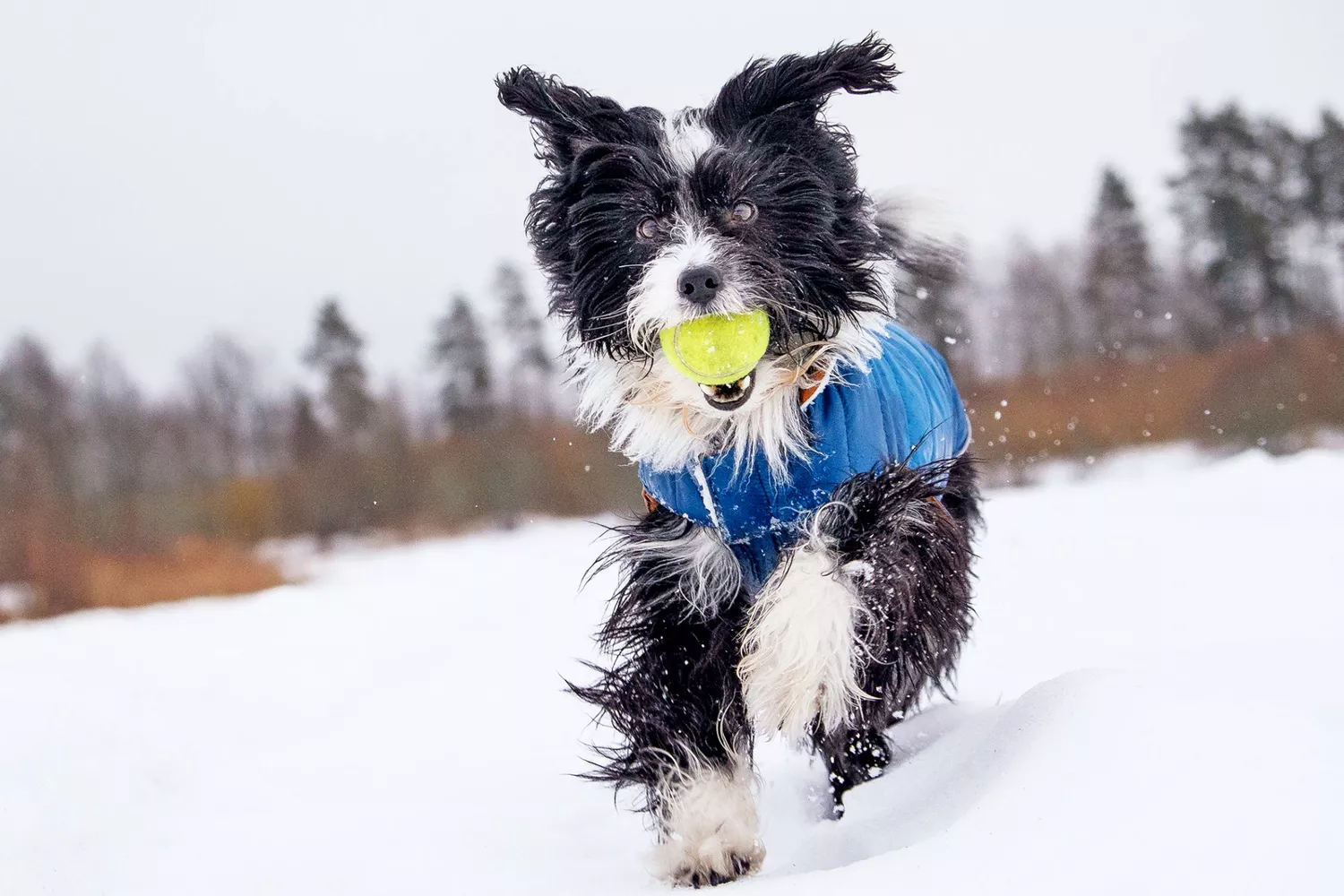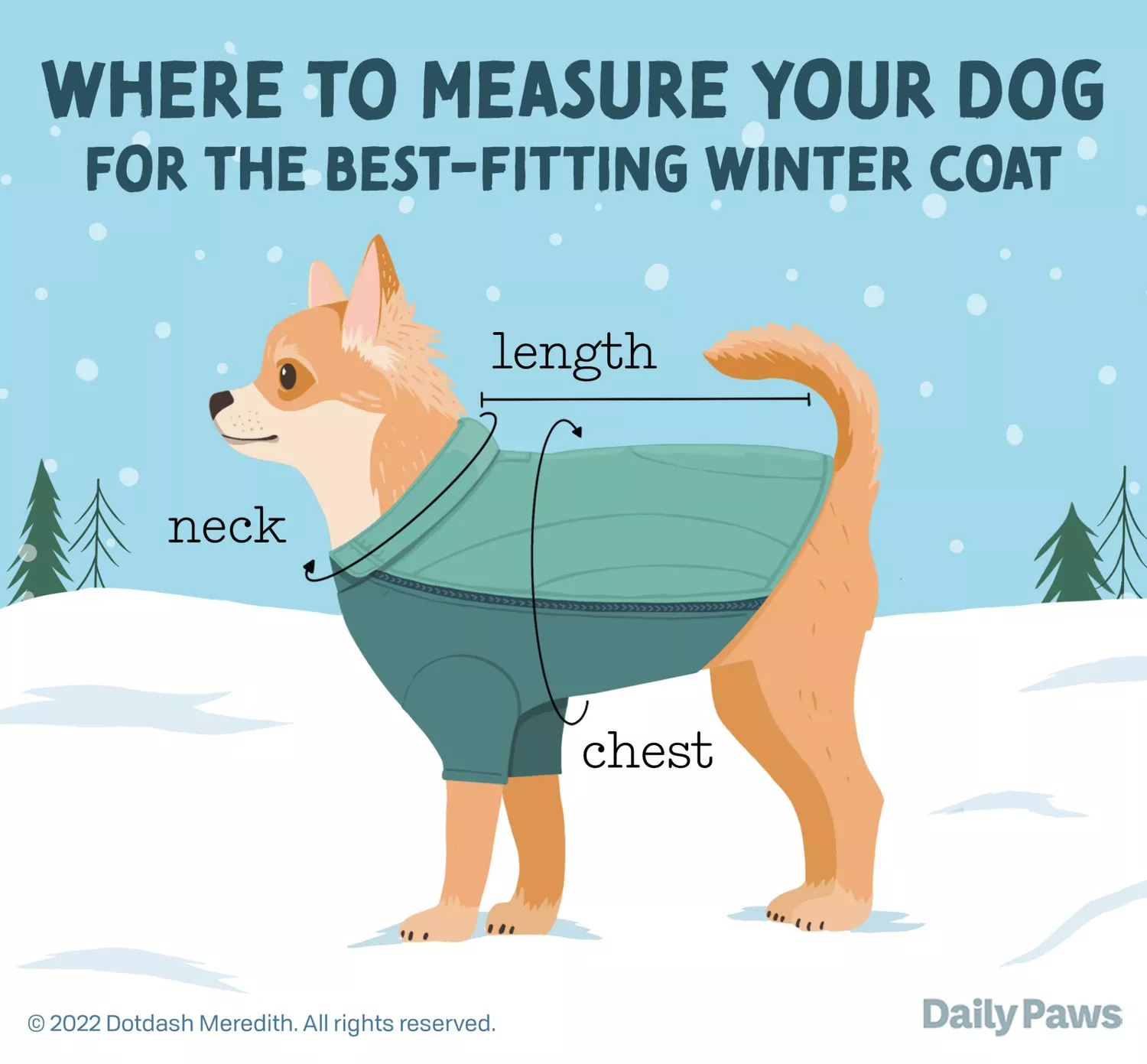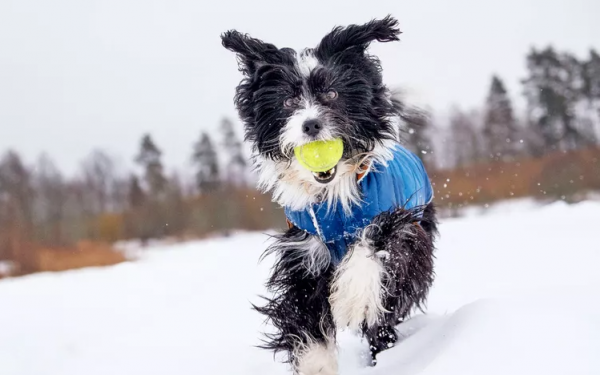When properly fitted, dog winter coats are an excellent solution for protecting your pet from the bitter elements. Sure, pups have fur (most of them anyway) but there are days when it’s just too cold for winter fun or even going outside for potty breaks without another cozy layer or two.

However, before you fill your shopping cart with all the stylish dog coat options, whip out a measuring tape because there’s not a one-size-fits-all jacket that keeps every pup snuggly warm. Don’t worry, though—we have easy steps to follow to guarantee the right fit.
Dog Winter Coat Measuring Tips
Pet clothing should be weatherproof yet flexible enough to accommodate the curves of their bodies and movements during exercise. Here’s how to measure a dog for a winter coat, choose the best fabric and design, and make it last for multiple seasons.
Jennifer Freeman, DVM, recommends that before heading to the store or selecting a coat online, take three measurements:
Body length: Measure from the base of the collar to the base of the tail. (This is the most important measurement because coat length can’t be modified by straps.)
Neck: Measure around the neck where a collar would normally sit.
Chest: Also known as the girth, measure the width of your dog’s chest behind the front legs.

Record these measurements in the notes section of your phone to keep for reference. After all, you might need them again for picking out a snazzy dog sweater for indoor comfort, too.
Keep Your Canine Warm All Winter Long With These Cold-Weather Essentials
How to Tell If the Coat Fits Right
Do this quick test: When your dog is wearing the coat, Freeman says you should be able to run your flat hand under each opening, along your neck and the straps. If you’re not able to do this, size up. Actual measurements ensure a better fit than simply following a S, M, or L chart. “No two dogs are built the same, so it’s important to look at jackets, and apparel in general, that fit their specific measurements,” she adds.
If your pooch is accustomed to wearing a harness on walks, it can be combined with a coat. The harness should fit over the jacket where you can see it, not under it, where it could become twisted and uncomfortable for your pet.
“A harness can be a great visibility aid as well,” says Angela Hook, researcher and product developer at Stunt Puppy and D-fa Dogs. “A good harness with powerful reflection not only makes your dog more visible, it also makes you more visible, too, effectively turning your dog into a beacon on a leash.”
Which Winter Dog Coat Materials Are Best?
Look for shell-type fabrics, which are multiple fabric layers condensed into a single layer and weather-treated, Hook says. These fabrics are popular in activewear because they are lightweight, stretchy, warm, and wind- and water-resistant but not stiff or heavy. Hook also recommends merino wool for warmth without bulk. (Bonus: It’s also odor-resistant and easy to launder.)
Another consideration? The coat your dog was born with. Hook says a reflective rain shell keeps double-coated dogs visible and dry without extra insulation. A soft-shell fabric blocks weather and maintains stability of fine-coated dogs’ natural body temperature while exercising outdoors.
“If the fabric feels rough to your own skin or if the fabric is stiff and not supple, watch for signs of matting on your longer-coated dog,” she says. “Just as in human clothing, the better the fabric choice, the better the garment.”
10 of the Cutest Winter Hats for Dogs
Which Dogs Need Winter Coats?
Some doggos with lean bodies, short hair, and tummies close to the ground benefit from another layer of faux fur to keep away the chill. Winter coats are a must for the following breeds:
Cardigan Welsh corgi
Chihuahua
Chinese crested
Greyhound
French bulldog
Italian greyhound
Miniature pinscher
Pembroke Welsh corgi
Pug
Russell terrier
Toy fox terrier
Toy poodle
Yorkshire terrier (Yorkie)
Whippet
Xoloitzcuintli (Mexican hairless)
Pay close attention to how your pet reacts to the winter weather: Is there obvious shivering? Does he make a beeline for the door after doing his business? Are there a few whimpers of discontent? Yep, he needs a toasty coat. And if he doesn’t like stepping on snow, he might need winter boots as well.
8 Tips to Keep Pets Safe During Extreme Winter Weather
Helping Your Dog Wear a Coat
Some dogs instantly love that extra layer, while others need encouragement. Freeman recommends “creating a positive association with the new coat, especially if they’re not used to wearing clothing. This can be done by providing lots of treats when showing them the coat, putting the coat on, and wearing it and moving around.”
Move through these stages over a few days, making sure he’s comfortable in his winter coat and able to move freely. You might have to try a couple of versions.
Caring for a Pet Coat
Frequent laundering can reduce the effectiveness of fabrics with weatherproofing treatments, Hook says. To prolong the life of your dog’s winter coat and freshen it up between washings, let it air out whenever possible and avoid storing it for extended periods of time while wet and dirty. Dog coats need to dry out between walks and activity.
When it’s time to wash, use a lint brush or sticky packing tape to remove as much hair from the jacket as you can. “You’d be amazed at how much fur you can remove with tape, and it’s much easier on fabrics than brushing,” Hook says. “This is for the benefit of your washing machine but also helps to get a better cleaning result.”
5 Tips for Washing Pet Coats
Hook recommends these steps when laundering pet clothing and coats.
Fasten all straps and buckles to prevent twisting.
Choose a hand/wool wash cycle if you can to slow the spin speed and minimize shrinkage and warping.
Use a mild detergent that won’t irritate the dog’s skin or harm the fabric.
Avoid fabric softeners because they can damage fabric with performance features such as waterproofing.
Skip tumble drying unless you are trying to shrink or puff up a jacket. Always check the manufacturer instructions before tumble-drying pet apparel.



